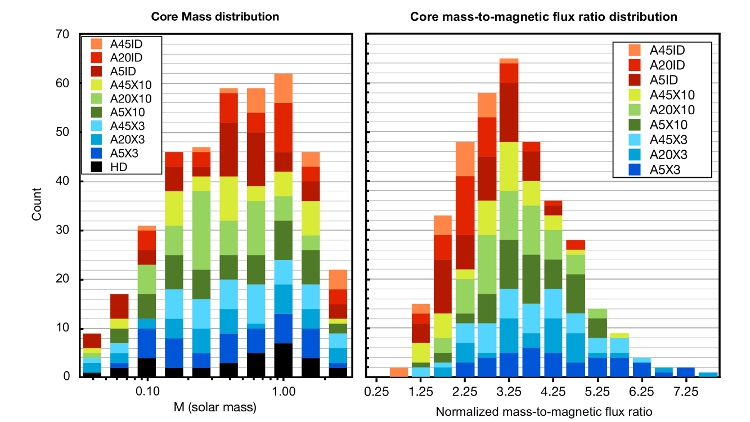| EPoS Contribution |
|
Formation of Magnetized Prestellar Cores with Ambipolar Diffusion and Turbulence
Che-Yu Chen U Maryland, College Park, MD, US | |
| We investigate the roles of magnetic fields and ambipolar diffusion during prestellar core formation in turbulent giant molecular clouds (GMCs), using three-dimensional numerical simulations. Our simulations focus on the shocked layer produced by a converging flow within a GMC, and survey varying ionization and angle between the upstream flow and magnetic field. We also include ideal magnetohydrodynamic (MHD) and hydrodynamic models. From our simulations, we identify hundreds of self-gravitating cores that form within 1 Myr, with masses M~0.04-2.5 solar-mass and sizes L~0.015-0.07 pc, consistent with observations of the peak of the core mass function (CMF). Median values are M=0.47 solar-mass and L=0.03 pc. Core masses and sizes do not depend on either the ionization or upstream magnetic field direction. In contrast, the mass-to-magnetic flux ratio does increase with lower ionization, from twice to four times the critical value. The higher mass-to-flux ratio for low ionization is the result of enhanced transient ambipolar diffusion when the shocked layer first forms. However, ambipolar diffusion is not necessary to form low-mass supercritical cores. For ideal MHD, we find similar masses to other cases. These masses are 1-2 orders of magnitude lower than the value that defines a magnetically supercritical sphere under post-shock ambient conditions. This discrepancy is the result of anisotropic contraction along field lines, which is clearly evident in both ideal MHD and diffusive simulations. We interpret our numerical findings using a simple scaling argument which suggests that gravitationally critical core masses will depend on the sound speed and mean turbulent pressure in a cloud, regardless of magnetic effects. | |
 | |
| Caption: Statistical distributions of mass (left) and mass-to-flux ratio (right) of self-gravitating cores formed in our simulations, from models with different upstream magnetic field directions (5, 20, and 45 degrees with respect to the converging inflow velocity) and ionization fractions. Red, green, blue, and black colors respectively represent models with ideal MHD, moderate, low, and zero ionization fraction. Core masses are relatively independent of magnetization, while the core mass-to-magnetic flux ratio varies depending on the ionization fraction. | |
| Collaborators: E. Ostriker, Princeton, US |
Suggested Session:
Cores |

